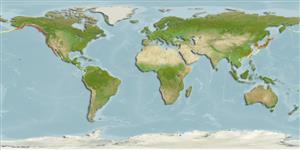Common names from other countries
Environment: milieu / climate zone / depth range / distribution range
Ekologi
. Subtropical
Pacific Ocean: Alaska to Mexico. Climate: boreal to tropical.
Length at first maturity / Size / Weight / umur
Maturity: Lm ? range ? - ? cm Max length : 3.5 cm SHL jantan/; (Ref. 312); common length : 3.0 cm SHL jantan/; (Ref. 312)
The peak near the front edge is far forward and may occasionally overhang the edge. The exterior varies in color but is usually brownish or olive green with a mix of large and fine dots. It is often pitted by a parasitic fungus and may have an eroded top (Ref. 312); Has a shell with an apex that is anterior. The anterior slope of the shell is concave and the posterior portion of the shell is convex. It has a strong ribbing on the posterior region. The shells are colored brownish green to greenish black and frequently appear eroded with white spots. The side of the foot is white (Ref. 310).
It has a shell length of 1.5 to 3.5 cm (Ref. 312). Habitat: Occurs in the high intertidal zone, on vertical and underside of rocks at low tide (Ref. 312); common in the high rocky intertidal zone and are typically found on vertical and overhanging rock faces and infrequently in tide pools; occasionally it is also found living on the goose-neck barnacle Pollicipes polymerus (Refs. 310, 95344). Inhabits deep cracks and crevices (Ref. 95344). Diet: microscopic films of algae; encrusting diatoms (Ref. 312). Behavior: Feeds at high tide when submerged. When exposed it becomes less active and attaches itself to the rock below usually with the anterior portion of their shell pointed down. It has the ability to secrete a mucus between its foot and shell that serves to secure on to the rock below and prevent desiccation and dislodgement. When exposed the heart and respiration rate also decreases. Respiration occurs through both a vascularized mantle fold and a single gill; in aggregate groups of 44 individuals. Predator: shorebirds and the crab Pachygraspsus crassipes (Ref. 312).
Life cycle and mating behavior
Kematangan | Reproduksi, perkembang biakan | Pemijahan | telur-telur | Fecundity | Larva
Reproduction: Spawning occurs in the winter, spring and summer. Has a short veliger stage. Typically the planktonic (veliger) larvae only remain in the water column for a few days to around a month. Recruitment of new individuals occurs typically from November to January. This short planktonic stage only allows for a limited dispersal of new individuals and recruitment is typically from the same or adjacent shore (Ref. 310).
rujukan utama
Acuan | Koordinator | mitra
Gallivan, G. and J. Danforth. 1999. (Ref. 312)
Status IUCN Red List (Ref. 130435)
status CITES (Ref. 108899)
Not Evaluated
Not Evaluated
penggunaan manusia
| FishSource |
Alat, peralatan
informasi lanjut
Umur / SaizPertumbuhanpanjang-beratpanjang-panjangMorfologiLarvaKelimpahan
Sumber internet
Estimates based on models
Preferred temperature
(Ref.
115969): 6.4 - 14.2, mean 9.1 (based on 384 cells).
kategori harga
Unknown.
